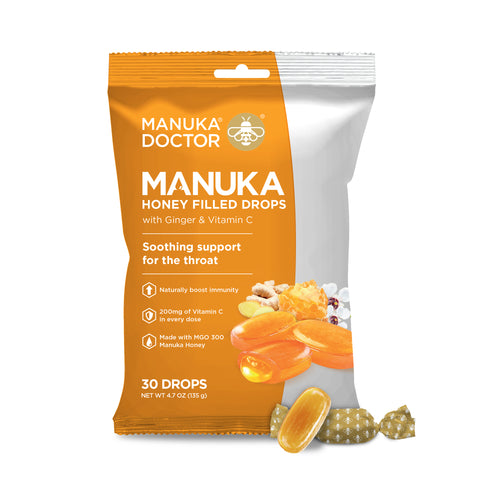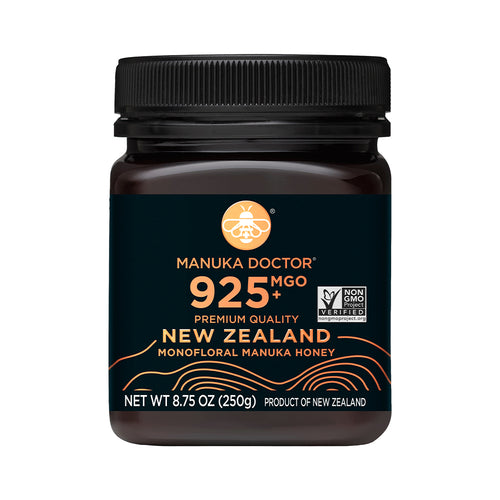Arriving in New Zealand, my first thought is that the countryside is quite similar to ours back home in the UK. But that impression is quickly dispelled as we bump along a gravel track in a 4x4 into a vast, rolling landscape of the most incredibly vivid green.
The farm where we finally grind to a stop is perched on top of a hill in a sea of undulating fields. On one side of us, the only distant sign of human life is the hilltop home of the neighbouring beekeeper. On the other, a grassy field dotted with wooden beehives slopes down to the edge of a wide, flat marshland carpeted with thousands Mānuka bushes and native trees – a habitat known as the New Zealand bush – which stretches back as far as the shadowy mountains on the horizon.

This is almost as far from Britain as it’s possible to be. I’m in Waikato, a few hours south of Auckland in New Zealand’s North Island, where I’m visiting one of Manuka Doctor’s hive sites for the first time.

In this natural world the only sound of human life is my own footsteps as I walk down through the grass towards a group of hives on the edge of the dense bush. But becoming louder and louder as I approach, is the persistent low hum of hundreds of thousands of honey bees which are flying from flower to flower, gathering Mānuka nectar to make honey. Every now and then there’s a higher whine as one whizzes past my ear.
It smells of damp grass – in New Zealand the late spring weather is as reliable as a British Bank Holiday weekend so it’s been raining this morning – and the comforting smell of wood smoke puffing out of a hand-held smoker the keepers use to calm the bees.
The Mānuka bush itself has an ugly beauty about it. The dark shrub was traditionally seen as a weed, similar to the way we view brambles in the UK, before the antibacterial benefits of honey made from its nectar were discovered. The bushes’ thin, bare trunks rise three or four foot from the ground into a mass of twiggy branches, like sticks of burnt candy floss. When they bloom, each bush is peppered with thousands of tiny flowers and the landscape transforms into a blanket of white.

If you asked a child to draw a flower, it would look like Mānuka: five simple white petals open around a bright red centre. And it’s this shape that attracts the bees. They love how easy it is to access the sweet nectar at the heart of the flower. During its short six to 12-week flowering season, Mānuka is the bees’ flower of choice.
This site houses just 150 of the 10,000 hives Manuka Doctor owns throughout New Zealand – and despite the rural surroundings it’s actually one of the least remote.
A few days later, I climb aboard a helicopter to visit one of the hardest-to-reach hive sites, nestled in steep mountain valley in the centre of a 27,000-acre wilderness owned and managed by the company. To get here by road, we’d have to drive for at least three and a half hours from the nearest main town, with the last hour on gravel tracks until all trace of road disappears completely. The beekeepers who check on the bees here every two weeks have to carefully navigate the final stretch across the rugged mountainside in 4x4 pick-up trucks, relying on GPS co-ordinates to find the hives.

We descend in a – slightly terrifying – corkscrew between the mountains to land on the valley floor. From there, it’s a steep walk down to a freshwater stream, where a group of hives squats next to the water in a small clearing encircled by Mānuka bushes. The air here is hot, humid and still, as a grassy bank shelters the clearing from the fresh breeze which whips through the valley floor above.
I sit and watch as honey bees emerge from the hives and quickly zip up the steep, Mānuka-covered valley wall beyond. The bees slowly work their way back down from bush to bush, gradually loading up with Mānuka pollen and nectar. They are so laden by the time they reach the valley floor I can tell which bees are on their way home by their lower, laboured buzzing as they return to the hive heavy with the spoils of their trip.

Apart from the constant hum of hard-working bees, there’s no other sound in this untouched green wilderness except the occasional rattle of a cicada. New Zealanders like to claim their land is “God’s country” and, whether you believe that or not, I’m convinced this isn’t far off paradise.







